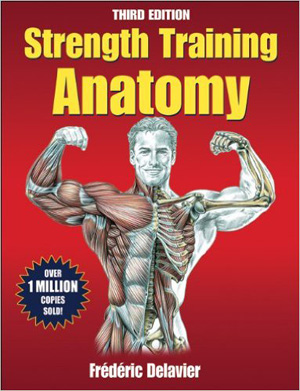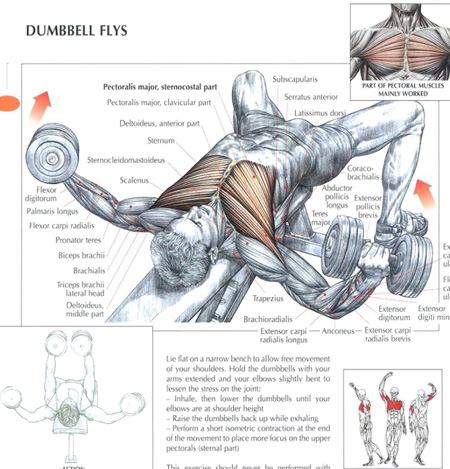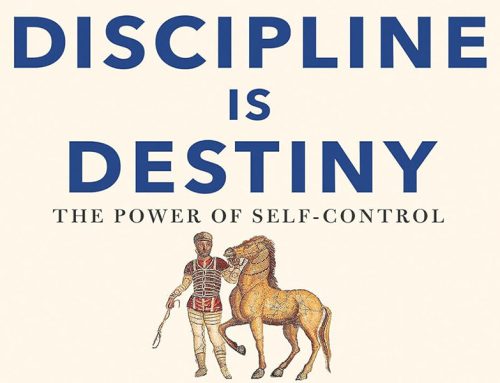“A great way to learn muscle anatomy and exercise form at the same time”
 I owned the first edition of Strength Training Anatomy (blue cover) for nearly 15 years and I’ve been recommending this book to my clients for that long as well. I decided to pick up the new 3rd edition (red cover) to update my library and also to write this review.
I owned the first edition of Strength Training Anatomy (blue cover) for nearly 15 years and I’ve been recommending this book to my clients for that long as well. I decided to pick up the new 3rd edition (red cover) to update my library and also to write this review.
This book’s concept and contents have been imitated many times, but Frederic Delavier’s is the original and the best.
I don’t know that much about the French author, except that he appears eminently qualified to produce this book – both the artwork and the exercise instruction. His bio reads:
“Frédéric Delavier is a gifted artist with an exceptional knowledge of human anatomy. He studied morphology and anatomy for five years at the prestigious École des Beaux-Arts in Paris and studied dissection for three years at the Paris Faculté de Médecine. The former editor in chief of the French magazine PowerMag, Delavier is currently a journalist for the French magazine Le Monde du Muscle and a contributor to several other muscle publications, including Men’s Health Germany. Delavier won the French powerlifting title in 1988.”
In a nutshell, Strength Training Anatomy is a book of expertly drawn illustrations of the human body (over 600) performing weight training exercises.
The primary muscles being worked are colored in red and clearly labeled. The bones, muscle fibers and muscular attachments are also beautifully illustrated.
The book is divided into seven sections: Arms, Shoulders, Chest, Back, Legs, Buttocks and Abdomen. No space is wasted with introductions – the book jumps right into arms in the opening pages. A page is devoted to each exercise, and a small amount of text accompanies each illustration, explaining proper form and giving additional tips or precautions.
Sidebars show exercise variations, start and finish positions and additional details (such as deep muscle anatomy with the exact muscle tendon insertions on the bone).

The length is 192 pages, so it’s not overwhelming – it’s very digestible, yet it’s also very thorough in terms of the number of exercises covered. All the major and important barbell annd dumbbell exercises are included. In addition, you’ll learn a variety of cable exercises and a handful of common and useful machine exercises.
I don’t think there’s any reader from any demographic or experience level that won’t benefit from owning this book. It will be appreciated by men and women, especially since both male and female models are used in the illustrations. For beginners, this could be a training instruction “bible” for learning how to do the exercises properly and understanding exactly what muscles are working.
I imagine some people might suggest this book is only suited for the beginner, and certainly, it’s a great book for beginners. But I think advanced trainees and even fitness professionals will find this book valuable as a reference guide and may even want to keep it on their shelf within arms reach.
This material is not just for bodybuilders, but as a bodybuilder myself, I think there is another potential benefit of this book that I haven’t seen anyone else mention. Bodybuilders need to learn how to enhance their mind to muscle connection and develop the ability to visualize muscle actions. Studying the drawings and looking at the muscles engaged, the direction of the fibers and where they insert and attach could be a great tool to help with these mental skills.
As for the 3rd edition, there is new material in this update, including much more content (it’s longer, with more exercises). There are also new sections on stretching and avoiding common injuries.
The publisher, Human Kinetics consistently puts out some great titles, and this is among the best of them. The book quality is excellent, including the cover, binding, paper, and again, the illustrations on every page are fantastic. The author is clearly a skilled artist who also has a medical-level understanding of the human body.
Potential readers should know before buying, that this book does not contain workout programs – it focuses solely on individual exercise instruction and exercise anatomy. That doesn’t detract from the value in my opinion, it actually helps keeps this volume concise and focused on one thing: strength training exercises and anatomy.
On that note, again, this is not a text-heavy book and while you do get an explanation and illustration of each exercise, you don’t get additional written details on biomechanics and muscle actions. You’re mainly getting exercise instruction and muscle anatomy lessons.
Also, this IS an anatomy book, so if looking at body parts and human anatomy bothers you, then you might want to take a pass. (All body parts are depicted, in places).
Last but not least, this would make a good gift, especially for your friends or family you know are just getting started with weight lifting.
In summary, this book deserves its 5-star ratings, and its sales and longevity in the fitness book market are not surprising.
Get Book At Amazon:
amazon.com/gp/product/0736092269/







Leave A Comment